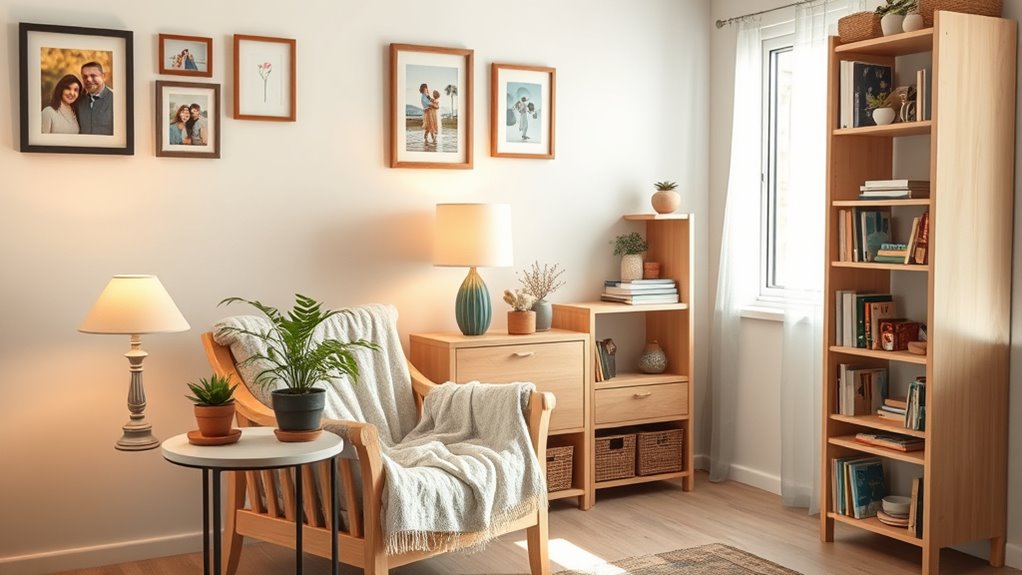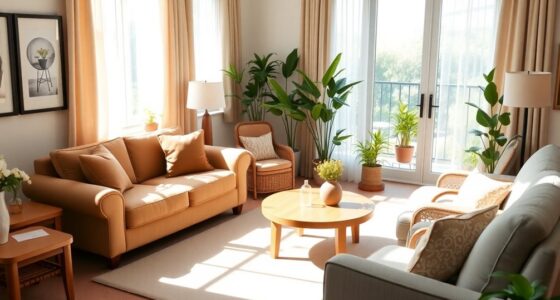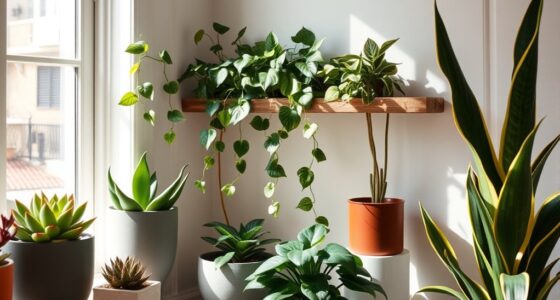To make your small senior living space safe, cozy, and personalized, focus on organization by keeping pathways clear and using storage solutions. Choose multifunctional furniture that saves space and feels comfortable, and arrange zones with rugs and furniture for a warm, inviting feel. Add natural light, plants, and meaningful décor to enhance comfort. Colors and patterns can enliven the space without clutter. Keep exploring for more tips to create a safe, stylish home tailored to your needs.
Key Takeaways
- Use multi-functional furniture with built-in storage to maximize space and utility.
- Incorporate bright lighting, mirrors, and light-colored decor to enhance natural light and create an open feel.
- Arrange furniture thoughtfully to define zones and maintain clear pathways for safety.
- Add indoor plants and natural elements to improve air quality and create a calming atmosphere.
- Keep clutter minimal with organizational solutions like baskets and labeled containers for a tidy environment.
Prioritize Safety and Organization
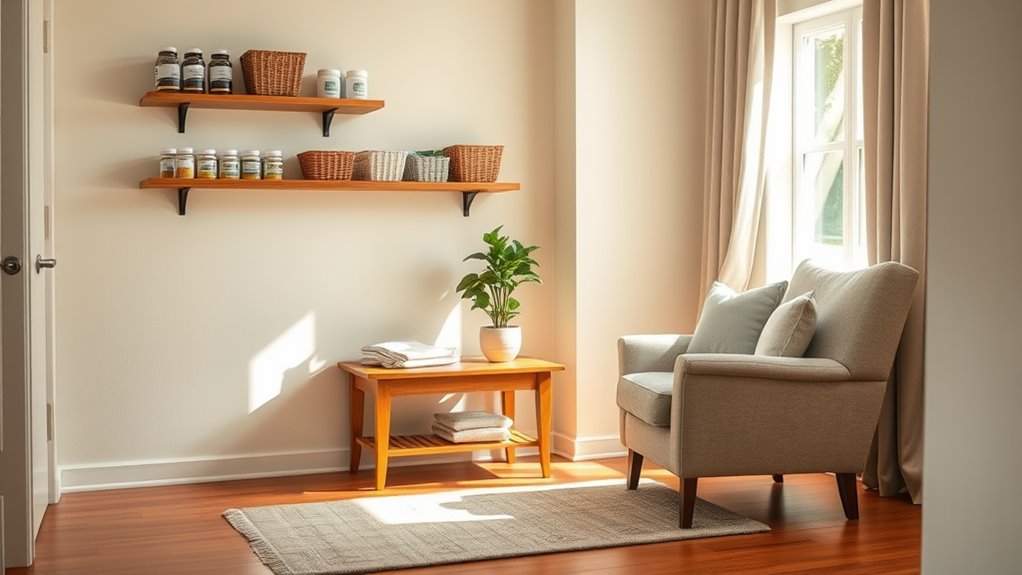
To create a safe and organized small senior living space, start by keeping pathways clear of cords, rugs, and decorative hazards that could cause tripping. Proper organization is essential for safety and easy access to essentials; use storage solutions like baskets, labeled containers, and organizational boxes to keep clutter contained. Incorporating space optimization principles can further enhance the functionality and safety of your environment. Regularly tidy the space to remove outdated materials and reduce overwhelm. Implementing storage solutions can make a significant difference in maintaining an orderly environment and reducing hazards. Arranging furniture thoughtfully to maximize safety, ensuring pathways remain unobstructed and exits are accessible. Avoid placing furniture or décor that can block pathways or create tripping hazards. Installing a memo board for notes and reminders helps keep important information in view without cluttering surfaces. Utilizing home organization strategies can also support maintaining a clutter-free and safe environment. Incorporating lighting upgrades can improve visibility and reduce accidents in small spaces. Implementing architectural solutions designed to optimize small spaces can further enhance safety and functionality. Prioritizing safety and organization minimizes hazards and creates a comfortable, accessible environment suited to your needs.
Maximize Space With Smart Furniture Choices
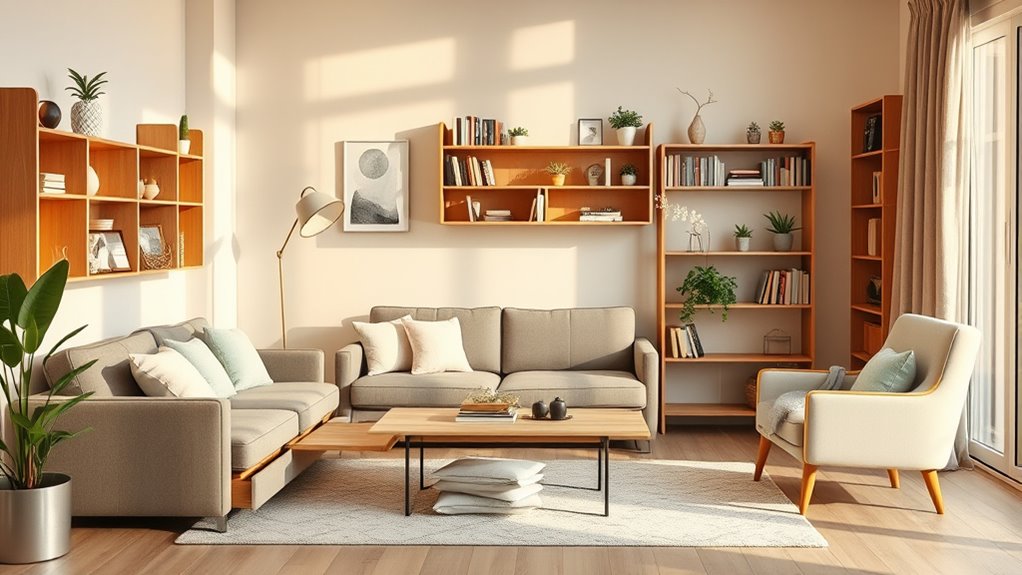
Choosing multi-functional furniture helps you get the most out of limited space, like beds with built-in storage or versatile ottomans. Make sure your furniture is scaled down to fit comfortably without crowding the room, so you can move around easily. Incorporating quality materials in your furniture ensures durability and safety in your living space. Using wall-mounted shelves and foldable chairs also creates flexible zones and frees up floor space. Additionally, selecting furniture made from eco-friendly materials can contribute to a healthier environment and a safer home. To further optimize your space, consider incorporating self watering plant pots, which can add greenery without requiring frequent maintenance or taking up extra space. Being mindful of ergonomic design in your furniture choices can also enhance comfort and support, especially for seniors who may have specific needs. Staying informed about AI safety developments can help in choosing innovative smart furniture options that enhance safety and convenience.
Multi-Functional Furniture Options
Maximizing space in small senior living areas is easier with multi-functional furniture that combines practicality and comfort. Multi-functional furniture like ottomans with storage or beds with built-in drawers helps you save space while providing essential storage solutions. Incorporating space-saving solutions can further enhance the efficiency of your setup by reducing clutter and improving flow. Additionally, selecting furniture with fire-resistant materials can improve safety in small living areas, especially when space constraints increase the risk of accidents.
Using resilience in choosing durable furniture ensures longevity and safety, making your space both functional and secure. Compact sofas or sectional seating can be rearranged to create different zones, boosting flexibility and making your space more adaptable. Folding tables and stackable chairs offer versatile options for dining, activities, or guest seating, and they can be easily stored away when not needed. Incorporating lightweight, mobility-friendly furniture facilitates easier rearrangement and access within the space.
Choose versatile furniture made from lightweight materials for easier mobility and rearrangement. Higher clearance pieces with supportive armrests make sitting and standing safer and more comfortable. Incorporating multi-purpose furniture can further enhance the usability of your space by efficiently combining functions, which is especially beneficial in small areas.
With smart furniture choices, you’ll maximize your space without sacrificing style or functionality.
Scale Appropriately for Space
Selecting furniture that fits your space is essential for creating a safe and functional senior living area. Proper scale ensures your furniture doesn’t overwhelm the room or hinder movement.
Measure doorways, hallways, and elevators to confirm each piece’s size and ease of transfer.
Choose smaller furniture with proportionate measurements, like compact sofas or chairs with narrow arms, to prevent overcrowding.
Multi-functional furniture, such as beds with built-in storage or fold-away tables, helps maximize utility without sacrificing space.
Rounded or oval tables improve flow and reduce sharp edges, enhancing safety.
Prioritize sturdy, supportive furniture with appropriate proportions, armrests, and higher seating to boost comfort and stability.
- Use measurements to select furniture that fits comfortably
- Prioritize proportionate pieces to prevent overcrowding
- Opt for multi-functional, space-saving options
Personalize With Meaningful Decor
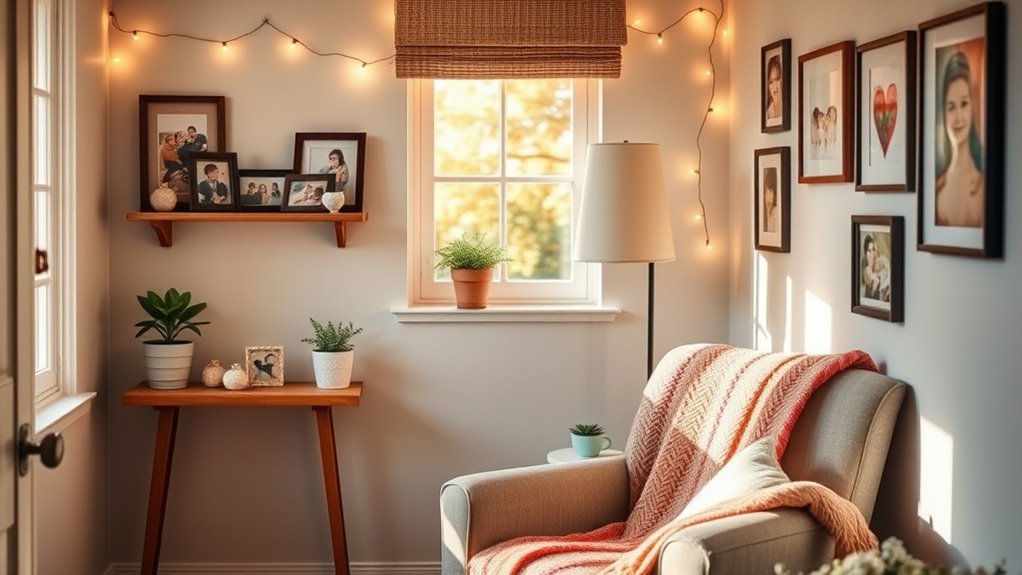
Adding meaningful decor transforms a small senior living space into a warm, personalized haven. You can display family photos, cherished keepsakes, and sentimental items like heirlooms or handcrafted pieces to evoke positive memories and create a sense of familiarity. Cookies enhance browsing experience Incorporating meaningful objects from hobbies or past experiences as focal points, reflecting your interests and history. Thoughtfully arrange personal possessions and personal belongings to enhance the décor, making the space uniquely yours. Select décor that resonates with your values and preferences, helping you feel more at home. Personalizing your environment with sustainable materials not only adds a special touch but also aligns with eco-friendly practices. Using meaningful objects that hold personal significance can further deepen the emotional comfort and connection to the space. Understanding divorce laws can help you navigate legal processes smoothly if needed. Additionally, incorporating music therapy elements, such as a small music player or instruments, can foster emotional well-being and enhance relaxation within your personal environment. These personalized touches provide emotional comfort and strengthen your identity within the space.
Incorporate Natural Elements and Lighting
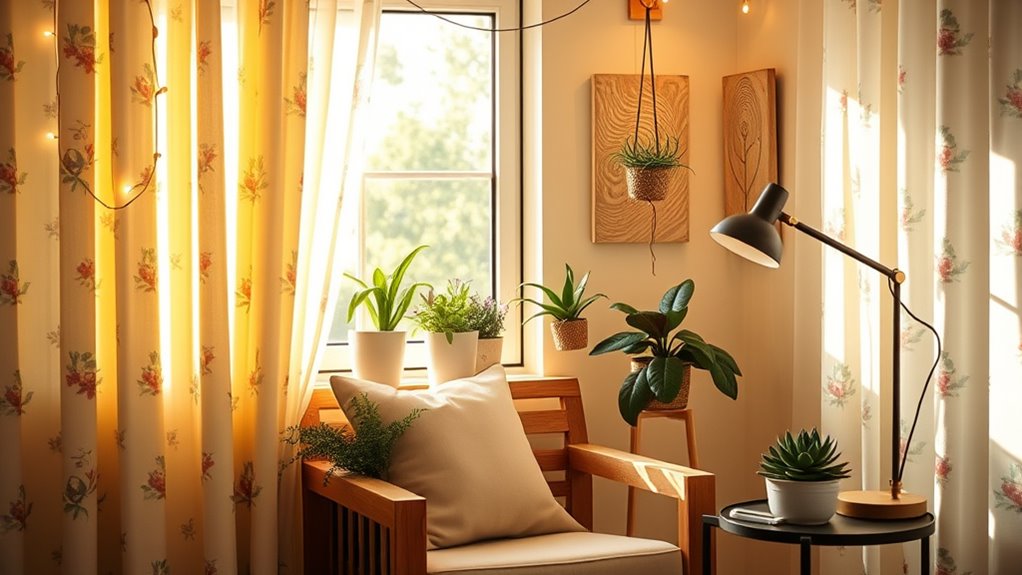
Bringing in natural elements and lighting can make your space feel more open and inviting. Consider adding indoor plants like succulents or ferns to freshen the air and add a touch of nature. Regularly monitoring for symptoms of breast cancer can help with early detection and prompt treatment. Maximize natural light by choosing light-colored window treatments and keeping windows unobstructed to brighten your room. Additionally, incorporating natural lighting techniques such as reflective surfaces can further enhance brightness and mood, similar to how Volkswagen Tuning optimizes engine performance for better driving experience. Using space-saving fixtures and layout strategies can also help make small areas feel more expansive and functional. To support plant health and growth, selecting the right watering techniques for large indoor plants can create a more vibrant and lively environment.
Use Natural Light Effectively
Maximizing natural light in a small senior living space can make it feel more open and inviting. Position furniture carefully to avoid blocking windows, and opt for sheer or light-colored curtains that let sunlight flow freely. Incorporate mirrors across from windows to reflect natural light, making the space appear larger and brighter. Additionally, integrating smart window treatments that can be controlled via automation can enhance lighting control and optimize sunlight usage throughout the day. Use light-colored walls, ceilings, and décor to enhance daylight and create an airy atmosphere. Choose window treatments that are easy to open and close, giving you control over the light throughout the day. Keep windows and glass surfaces clean to ensure maximum brightness and transparency.
- Place mirrors strategically to amplify light and space
- Select curtains and window treatments that enhance sunlight flow
- Use glossy surfaces to reflect light and add a sense of openness
Add Indoor Plants
Incorporating indoor plants not only enhances the aesthetic appeal of your senior living space but also introduces natural elements that boost well-being. Indoor plants like succulents, pothos, and snake plants thrive in low-light conditions and require little maintenance, making them perfect for senior living spaces. They improve air quality by filtering pollutants such as formaldehyde and benzene, creating a healthier environment. Strategically placing these plants near windows or well-lit areas maximizes natural light, helping them flourish and brightening the space. Care routines for indoor plants can also serve as therapeutic activities, fostering a connection with nature and giving residents a sense of purpose.
| Natural Elements | Space Enhancement |
|---|---|
| Improve air quality | Brighten small areas |
| Promote relaxation | Encourage therapeutic activities |
Use Color and Patterns to Enhance Visual Appeal

Using color and patterns thoughtfully can markedly enhance the visual appeal of small senior living spaces. Light, neutral hues on walls and large furniture create an open, airy atmosphere, making the space feel larger. Incorporate accent walls with calming patterns or subtle textures to add visual interest without overwhelming the room.
Patterned throw pillows, rugs, and curtains bring color and personality while maintaining harmony. Wallpapers or decals with soft, simple patterns add depth and reduce monotony.
- Use contrast wisely: dark furniture against light walls to define spaces
- Choose calm patterns for walls and textiles to avoid visual clutter
- Mix textures and patterns to create depth without cluttering the space
Create Functional and Inviting Zones
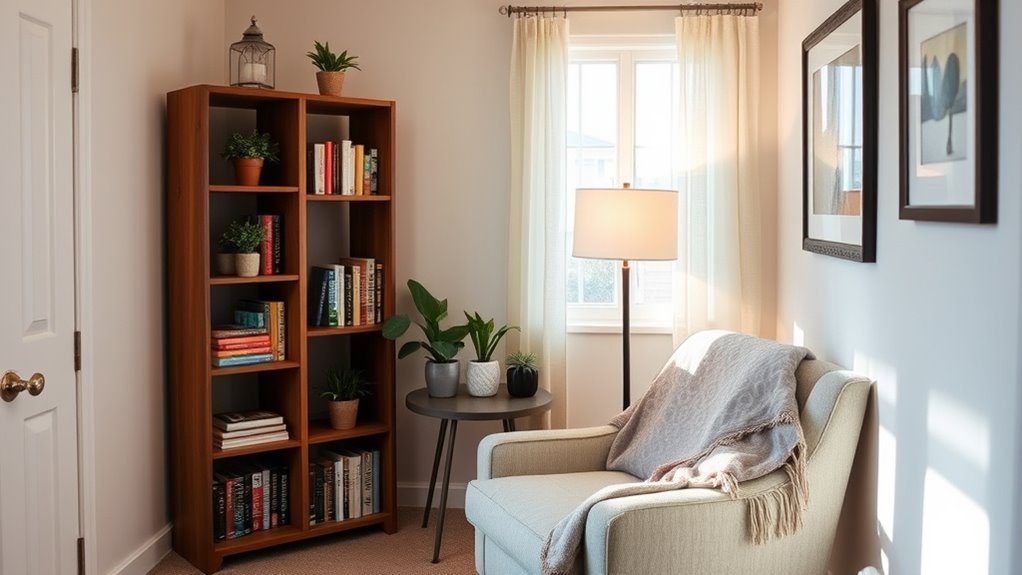
Color and patterns can set the tone for different areas in your small senior living space, making it feel more organized and welcoming. Use furniture placement and area rugs to create visual zones, such as a cozy sleeping corner or a functional dining nook.
Incorporate multi-purpose furniture like sofa beds or storage ottomans to maximize space and utility within each zone. To maintain a clutter-free environment, plan your space carefully with smart space planning, ensuring clear pathways and easy navigation.
Room dividers, curtains, or open shelving can define private areas without closing off the space. Decorating tips include assigning specific themes or color schemes to each zone, making them feel intentional and inviting while enhancing overall flow.
Frequently Asked Questions
How to Decorate a Small Assisted Living Space?
When decorating a small assisted living space, you should prioritize functionality and comfort. Measure your furniture and doorways to guarantee everything fits easily.
Use multi-purpose pieces like storage beds or ottomans, and incorporate vertical storage with wall shelves and hooks.
Opt for light colors and good lighting to make the room feel larger.
Personalize with photos and heirlooms to create a cozy, inviting atmosphere that feels like home.
How Do You Style a Small Living Space?
When styling a small living space, you want to make it feel inviting and functional. Use light colors and mirrors to reflect light and add a sense of openness.
Opt for multi-purpose furniture to save space, and define zones with rugs or furniture arrangement.
Keep décor minimal and organized, adding personal touches that warm the room.
Vertical storage helps free up floor space, making your area feel larger and more comfortable.
Where to Put TV in a Small Living Room?
So, you’re wondering where to put the TV in your tiny living room—imagine that! You should mount it on the wall to save space and reduce clutter.
Position it at eye level when seated for comfort. Use a low-profile stand or multi-functional furniture to keep things tidy.
Avoid placing it opposite windows to cut glare.
With these tips, your small space will feel bigger and more cozy.
How to Make an Old Flat Look Nice?
To make an old flat look nice, start by updating the walls with light, neutral colors and hanging mirrors to brighten and expand the space.
Incorporate multi-functional furniture to save room, and keep décor minimal and organized with vertical storage.
Add personal touches like photos and heirlooms to create warmth.
Use soft lighting and colorful accents to make the flat cozy, inviting, and visually appealing without clutter.
Conclusion
By following these decorating tips, you’ll transform your small senior living space into an oasis so perfect, it’ll feel like stepping into a luxurious retreat every day. With smart choices, personal touches, and clever design tricks, you’ll turn every inch into a haven of safety, comfort, and style. Before you know it, your tiny space will rival the grandest mansions in charm and functionality — proving that size truly doesn’t matter when your heart and creativity lead the way.
